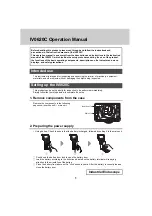
INTRODUCTION
Congratulations on your purchase of the Nady ASM-2 sound level meter. You’ll find that it is an extremely versatile
device for measuring sound intensity in just about any acoustic environment-loud or soft; high-pitched, low-pitched,
or broad-band; intermittent or continuous. You can use it to measure noise levels in factories, schools, offices, and
airports, or to check acoustics of studios, auditoriums, and home theater installations.
Your meter features a large, easy-to-read indicator for taking quick measurements anywhere. Power is supplied by
a 9-volt alkaline or NiMH battery, so the meter is completely portable.
The meter’s other features include:
• Seven sound-level ranges—allow measurements from 50 - 126 dB (referenced to 0.0002µbar).
• A and C weightings—lets you check compliance with safety regulations as well as make acoustic analysis.
• Slow and fast response settings—let you check peak and average noise levels.
• Built-in battery condition indicator
• Phono-type output jack—for connection to home theater or test equipment.
• The Threaded insert—lets you attach the meter to a camera tripod for increased accuracy.
INSTALLING A BATTERY
The meter uses a 9-volt battery. For the longest life and best performance, we recommend an alkaline battery.
Open the battery compartment cover by pressing both sides at the lower striped portion and lifting the bottom. Insert
a battery into the compartment as indicated by the polarity markings (+ and -) marked inside.
To test the battery, set RANGE to BATT. If the meter shows a reading in the red BATT TEST region, the battery is
still good.
Notes:
• Leave RANGE in the OFF position when the meter is not in use to conserve battery power.
• Remove the battery if you are not going to use the meter for a week or more.
RANGE
The RANGE selector lets you select one of seven sound level ranges, each spanning 16 dB. The numbers on
RANGE refer to the center points of the seven ranges. The needle indicator shows the actual sound level as a
displacement from the center point. For example, if RANGE is set to 80 and the meter scale reads -3, the actual sound level is 77 as the value where RANGE
is set, the actual sound level is 80 dB (80+0).
OUTPUT
The phonotype OUTPUT jack lets you connect the meter to recording or other measurement equipment. For example, you might use an audio patch cord to
connect the meter to the AUX or high-level input of a recorder. Note that the meter response will not be flat, due to the A- and C-weighting networks.
Set Range so the maximum needle deflection is never greater than +4, to prevent the built-in amplifier from clipping. Use A-weighting for voice recordings, or
C-weighting for full-range musical material. The OUTPUT jack can also be connected to high-impedance headphones, or an oscilloscope, a frequency
analyzer, or other test equipment.
RESPONSE
The RESPONSE selector has two settings: FAST and SLOW. In the FAST position, the meter reacts quickly to changes in the sound level, showing you the
peak sound levels present in the enviroment. In the SLOW position, the meter is damped and indicates an average-value sound level. The effect of brief sound
peaks is minimized in this position.
WEIGHTING
Set WEIGHTING to weight the sound measurement for a particular frequency range. When set to A, the meter primarily measures frequencies in the 500-
10,000 Hz range, which is the area of greatest sensitivity to the human ear. When set to C, the meter measures uniformly over the frequency range from 32-
10,000 Hz,giving an indication of the overall sound level.
MICROPHONE
The meter’s built-in microphone works best when you point it directly at a sound source.
TRIPOD ADAPTER
You can mount the meter on a camera tripod (standard 1/4-20 thread) to eliminate hand noise and minimize the effects of sound reflected from your body. This
makes it easy to use the meter with auxiliary recording or test equipment.
CAL(CALIBRATION)
Your meter has been accurately calibrated at the factory and normally will not require further adjustment. If necessary, an audio professional can use the CAL
hole on the meter with special equipment, including a sound generator, to calibrate it.
U S E R G U I D E
ASM-2
— Seven-Range Sound Level Meter




















